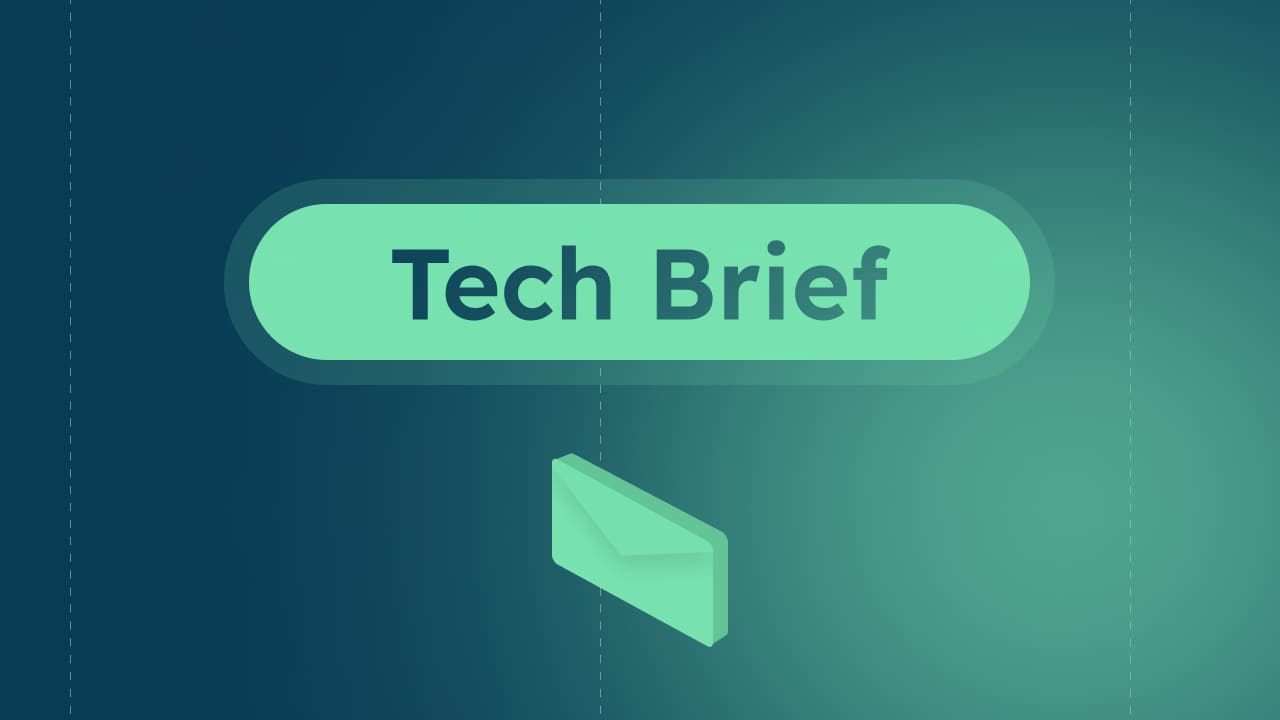Introduction
According to the State Of Mobile 2022 study, the French spend an average of 3.5 hours per day consulting their mobile phone. It is 1 hour more than in 2019, even though the authorities and academics are constantly warning about the side effects caused by extensive mobile phone use:
-
FOMO (FEAR Of Missing Out) syndrome,
-
anxiety,
-
sleep disturbance and difficulty in sleeping peacefully,
-
difficulty in staying focused on a single task due to the unstoppable flow of notifications.
Given the omnipresence of mobile phones, it is hardly surprising that 8 out of 10 French people report being distracted drivers. Driving while distracted occurs when a motorist use a handheld smartphone while driving.
Although formally prohibited by the French Traffic Safety Administration because of the inherent risks for other road users (cyclists and pedestrians) and the risky behaviors induced by a lack of attention (excessive speedings, increased reaction time, late or untimely braking, higher risk of committing other road traffic offenses, car crash), using of a mobile phone at the wheel continues to gain ground from one year to the next.
|
Using the phone while driving can be an expensive violation! Penalties in France are already severe. A driver caught using his phone in his car must pay a fixed fine of 135 euros and lose three points on his driving license. If the phone use is combined with another offense, such as running a red light, the driver may have his license immediately suspended, and be administratively suspended for six months. |
Phone use in the car varies from making calls while driving (52%), to GPS navigation via dedicated mobile applications (45%), to texting (34%).
These surveys of motorists are relevant for quantifying some of the distractions. However, they lead to other questions that are difficult to answer via these traditional methods. At what time is distracted driving most intensive? In which road conditions are motorists most distracted?
With our smartphone telematics technology, it is possible to provide answers to these questions to better define the driving behavior of distracted motorists.
The analysis below is based on data from policy holders who have subscribed to connected car insurance offers. This data was collected by our solution for a period of 6 months.
Each of the two groups were made up of 4,000 drivers:
- Group A was made up of young drivers;
- Group B included a more homogeneous population in terms of age distribution.
At what times does distracted driving occur?
|
How to detect the hours most conducive to distraction? Smartphone telematics makes it possible to obtain the precise chronology of the most conducive moments for the use of the phone while driving. This can be seen by displaying the call intensities on a heat map in two-dimensions: the day of the week and the time of day. |
The dark colours of the following heat maps correspond to the periods when the density of phone calls was the highest.
Heat Map of intensity of Group A calls

Heat Map of intensity of Group B calls
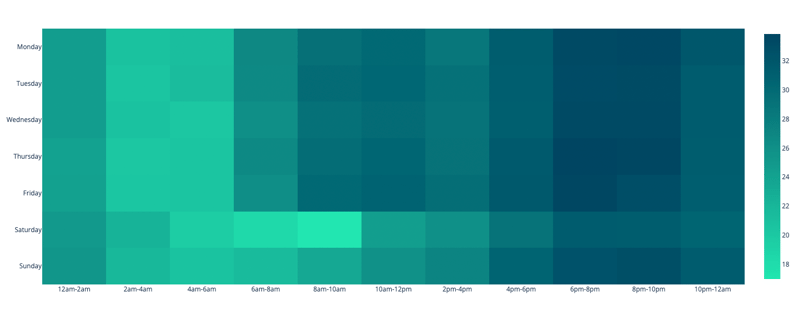
The heat maps did not reveal a fundamental difference between the two groups. We noted that there were more calls on weekdays than at the weekend.
The time range where the intensity was maximum, which therefore corresponded to the peak of use of the phone, was between the end of the afternoon and the beginning of the evening, between 16:00 and 20:00. Finally, the most phone calls on these time slots were concentrated on Thursdays and Fridays.
In what road conditions does distracted driving occur?
|
How do we determine the road conditions most conducive to cell phone use? Beyond the date and time, smartphone telematics makes it possible to accurately assess the distribution of the road contexts of the trips made. The contexts were determined according to the average speed of the movements measured during a trip. |
The graphs below represent the distributions of driving time by road context of drivers of groups A and B.
Percentages of distribution of road contexts by driving time
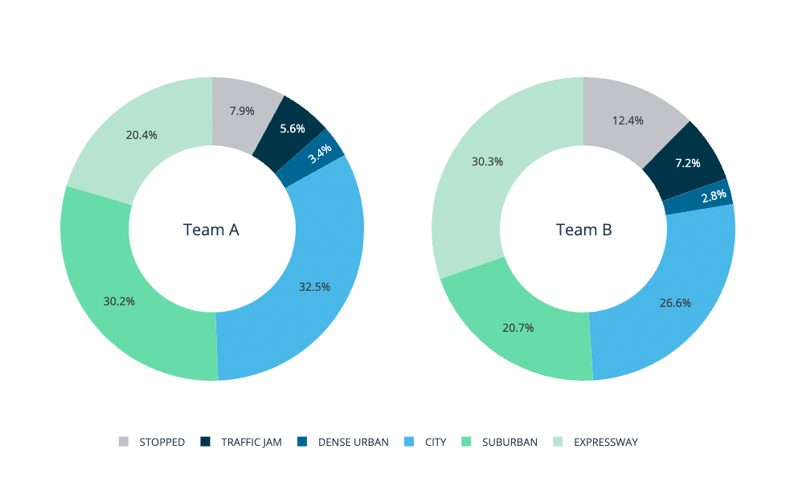
To compare the two groups, distraction events in relation to driving time in each road context were standardised. Thus, it was possible to compare the two groups in terms of frequency of unlocking and calls by road context, despite a different distribution of contexts.
Frequency of unlocking by road context
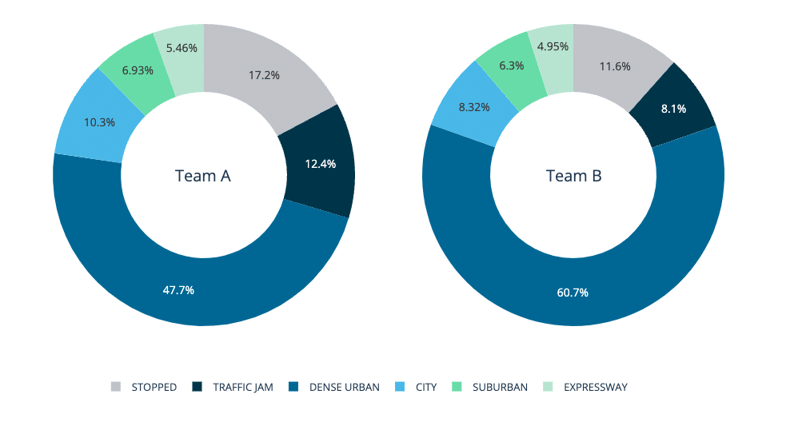
Frequency of calls by road context

The graphs indicate that the use of the phone while driving was more common in urban areas and at speeds below 30 km/hr. Although drivers of groups A and B spent about 50% of their travel time in non-urban areas and expressways, the use of the phone in these contexts was marginal.
On the other hand, in urban areas and at lower speeds, there was a relaxation of caution, probably because the perception of danger was lower. This impression is very relative though as, although the urban context minimises the potential injury for the driver and damage to the vehicle, it is particularly dangerous for other road users (pedestrians, bicycles, bikes). In fact, ¾ of road deaths occur in urban areas, and 74% of fatal accidents occur during daily or short trips.
Finally, 30% of the distraction events in group A and 20% of the distraction events in group B occurred when the vehicle was stationary (stops, traffic lights), or in traffic jams. However, the law is unambiguous: it is forbidden to handle a mobile phone even when stationary, as it creates an attention deficit.
Conclusion
Our study provides additional evidence to better understand the phenomenon of distracted driving behind the wheel and the circumstances in which a driver is likely to pick up his phone while driving:
-
The 4 pm-8pm time slot concentrates the most calls,
-
Distraction peaks on Thursdays and Fridays in this time slot,
-
Motorists are most distracted in cities below 30 km/h.
Insurers that launch a smartphone telematics program can accurately measure the distraction profile of their policyholders and the circumstances in which their customers are likely to get distracted and therefore increase their risk of an accident. With this information, insurers can launch road safety programs and targeted messages to their customers to alert them to the dangers of distracted driving on time.
|
This article is adapted from our white paper dedicated to the fight against distracted driving. Download our white paper to :
|



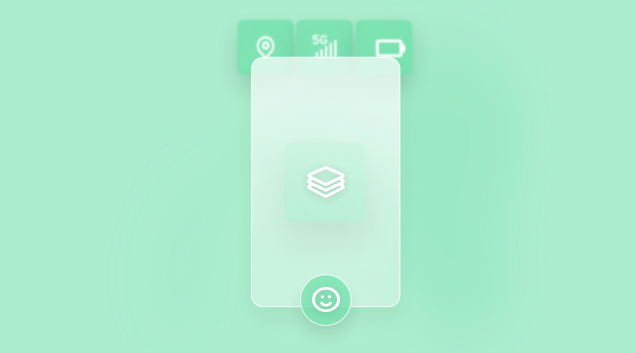
![[2025 Edition] The Guide to Connected Insurance](https://blog.drivequant.com/hubfs/7-%20%5BEdition%202025%5D%20Le%20Guide%20de%20lAssurance%20Connect%C3%A9e.png)
